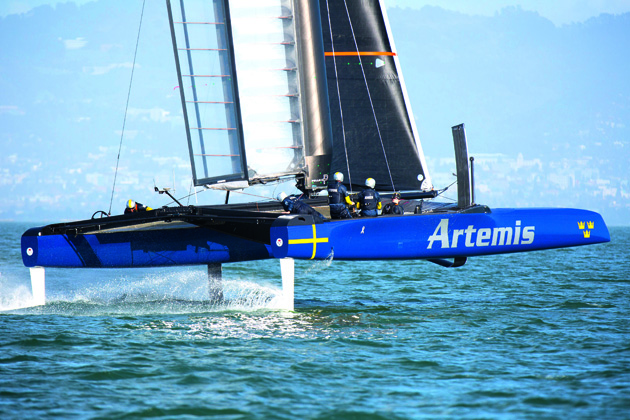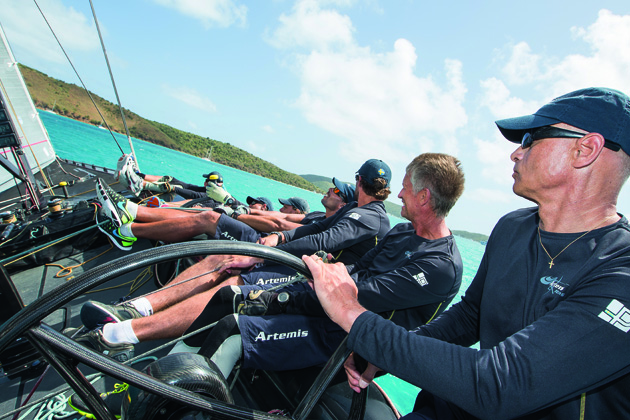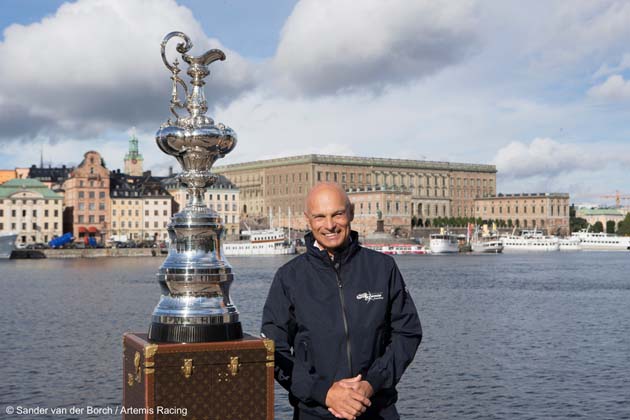The man behind the Artemis Racing America’s Cup team, Torbjörn Törnqvist, rarely gives interviews, but he spoke candidly to Matthew Sheahan about his motivations for backing a Cup team
You have to look carefully to spot Torbjörn Törnqvist. Wearing identical gear to the rest of his crew and listening intently to the pre-race briefing and post-race analysis in the cockpit, he has little, if anything, to single him out. Indeed, it’s only after the start that you can positively identify the billionaire owner of the Artemis Racing team as Törnqvist always helms his RC44.
The same was true aboard his red TP52 of the same name. If the boat was racing, he was helming. Otherwise, there was nothing in his behaviour, body language or clothing to make him stand out. The team let the results do the talking, particularly in 2007 when they won the TP52 Medcup Series and the season championships, an impressive achievement for an amateur owner/driver competing in a fleet swarming with professionals.
Here in Malta, aboard his RC44 at the first regatta of the 2015 season, Törnqvist is again at the helm, battling to keep pace as the fleet punched its way upwind in the big swell reflected off the rocky shoreline.
Törnqvist (61) is one of the wealthiest men on the racing circuit, a successful entrepreneur who has made and continues to make his money trading oil and petroleum products. His company, Gunvor, is said to be the fourth largest crude oil trader in the world. Törnqvist is quoted in Bloomberg Business as being worth US$3.8 billion.
From breakfast to dock-in, he travels with his crew. There is no RIB to buzz him out to the start or to whisk him back to the shore either side of the racing; when others dash for their laptops and phones to make important business calls he remains one of the crew. It’s the same at meal times.
“While our dinners might seat 25, you’ll never find him at the head of the table; he’s just on one of the chairs,” explains Artemis Racing’s team manager and RC44 tactician, Iain Percy. “When we are on tour we all stay in the same place, which means that we all get to stay in some nice hotels from time to time, but we’re all on the same floor and all eat together. It’s an important part of the team.”
In with the action
Tackling competition head on is another of Törnqvist’s assets. Where many in his position might prefer to exploit their boat’s technology or rating to lever themselves onto the podium, Törnqvist is not afraid to be judged in the cut and thrust of one-design racing, where ability rather than technology wins the day.
“He could sail any boat he wanted, but at one end of his sailing he’s running an America’s cup team, while at the other he chooses to helm an RC44, a competitive one-design in which there are a lot of crack teams,” continues Percy. “I respect him a lot for that. I guess his confidence comes from his trading background where it’s fiercely competitive.”
Focused, committed and deeply competitive on the racecourse, yet quietly spoken, reserved, charming and modest ashore, Törnqvist is easy to get on with.
With his America’s Cup campaign now in its second cycle and facing equally well-funded and technically advanced campaigns, he is fully aware of the need to be totally committed to engineering a faster, more capable boat. Yet he also sees the appeal and benefits of one-design racing.
“I like one-design,” he declares. “It’s the fairest form of racing. You’re first over the line and you win. Having said that, I’m fascinated by the design side and happy to talk about that for hours. I like all kinds of design and I’m interested in the development of sailing and the compromises that have to be struck. But that’s no different to business or indeed life. You have to make compromises.”
According to Percy and apart from the obvious financial backing that Törnqvist brings to the team, it is his support in running a big group that has been of most help to the triple Olympic medallist.
“He trusts his people,” says Percy. “On the big strategic issues I talk a lot with him and ultimately these decisions are his call. But when it comes to running the team, it’s down to me and he trusts me with that. I couldn’t ask for any more support. When there are tough decisions to be made we will talk things through and he gives me the courage to take them, but he’ll never tell me what to do.“
‘Careful in war’
Törnqvist’s willingness to have belief in his employees may sound obvious, but as the America’s Cup has frequently proved, not every team owner can resist the temptation to get more deeply involved in running the team. The name of his company, Gunvor, provides a good clue to his style. As well as being his mother’s name, it is also an old Norse word meaning ‘careful in war’, and according to those who work closely with him, this sums up the Swedish-born billionaire’s approach perfectly.
“My main contribution is in the management. Management is about making the best of the people who work for you,” he says, “and you will only be remembered for what has been achieved.
“I’ve seen many examples of things going wrong in business because people are insecure and need to have control. This doesn’t bring out the best in teams and often means people just keep quiet and are afraid to speak out; conflicts are then created. There are many America’s Cup campaigns that have ended in this way. But Iain and I share the same philosophy in that you need to let people flourish.
“I’m delighted if someone in my organisation does the job better than I can. When I was younger I probably would have minded,” he adds with a wry smile. “But that’s how you achieve things, particularly now when Cup sailing is changing so rapidly. You cannot fall back on history. People carry too much history with them in this sport, we made that mistake and that’s why we failed.”
How did ‘carrying too much history’ lead to failure?
“By not being open enough, not questioning our own experiences,” Törnqvist explains. “Our modelling in the last Cup never predicted foiling. It was the same for Oracle. There are times when you have to question the way that you work and I’m very happy with what I see in our own team now. I believe this is a team that has true talent and that has no internal politics, that’s our philosophy. If an idea comes from the shop floor, we listen to it as much as we would if it was from the design team or anyone else.
“Of course with a team of 60 people we have to have a structure, but it’s quite flat. Someone like Iain has a difficult job in this respect as he has to be the ringleader. I’ve seen others in this position try to dominate just to secure their own position, either because they think they have weaknesses that they need to conceal, or for other reasons.”
Tragedy in San Francisco
Nowhere was this put to the test more than after the team’s tragedy in 2013 and the death of Andrew ‘Bart’ Simpson.
“We decided that we would go on, but not with the existing structure so we tore everything down and let people take decisions on how they wanted to work and move on,” says Törnqvist. “We eliminated an entire management structure within Artemis.”
This move put Percy in charge of the team and saw the departure of the former team CEO Paul Cayard. By his own admission this was a big step for Percy at a time when emotions were raw.
“What was so important to us about Torbjörn’s approach was that he said: ‘I’m not making you carry on, but I will support you if you want to’,” explains Percy. “We knew we couldn’t succeed, at least not in Cup terms, but coming back in the way that we did was very important to us. We came back and felt that we’d achieved something special and it created a bond within the team.”
Late developer
Perhaps one of the most surprising things about Törnqvist’s involvement in racing is how late he got into it and how quickly he has become a top owner/driver.
“Although I started sailing at school when we were sent on summer camp in Stockholm when I was about ten years old, I didn’t start racing until I was 50,” he says. “For most of my life I’ve been family sailing, chartering boats.”
Törnqvist started sailing with Russell Coutts at the Swan Worlds. Coutts then “talked me into a TP52 and we won the Med Cup and the championships all in the same season. But now I have become fascinated by the Cup, the technology and how the event could be improved.”
As our conversation moves towards a new class for the America’s Cup it becomes clear that Törnqvist’s enthusiasm for the Cup extends far beyond simply winning the silverware. The future of the prestigious event is important to him, but so is the cost, even for someone of his means.
“I would like to see shorter cycles, two years,” he declares. “You could juggle around Olympic cycles by taking it to, say, the Southern Hemisphere so that you don’t have to race within the Northern Hemisphere summer.”
“Obviously I’d like to win the Cup and am spending huge amounts of money to do so. But is it really justifiable to spend this type of money? It’s not,” he continues. “In some ways it’s a bit of an ego trip and it’s not in keeping with the times. I feel a moral responsibility to fight to make this Cup accessible. Although I can afford it, such high costs are not good for the sport.
“With such complex and high-performance boats, skills would still be required and the Cup would still be extremely difficult to win. But with the current high costs, sponsors are not coming forward. They don’t want to be seen splashing out money on what they think are the wrong kind of people. It is also a little ridiculous when you have some of the richest people asking for sponsorship.
“The costs need to come down and the teams run on a more commercial basis for the event to go forward. I don’t think the Cup will be fully commercial and you will still have individual sponsors. But today it is simply too expensive and it’s not taking the Cup forward.”
Törnqvist represents a new era of wealthy individuals who are taking a more altruistic view of the future.
“I now understand a bit more about what drives Larry Ellison and I honestly believe that he truly wants to make the Cup sustainable, affordable and special,” he says. “Of course, he’s a winner and doesn’t want to give up. But the Cup is his legacy now, he wants to show that the Cup can be special. He thinks more about the future of the Cup rather than what it takes to win it.
“He could outspend anybody if he wants to, but it’s not as simple as that. He’s behind this new move, I’m sure of that and in doing so he’s reducing his own chances. But he’s doing it for the future of the Cup.”
Of course, Törnqvist cares about winning the Cup too: “But I do also believe in what is good for the Cup and what it needs to survive.” Whether he wins the Cup or not, Torbjörn Törnqvist’s approach could turn out to be one of the key influences in sailing’s richest trophy. Yet it’s likely that he’ll still remain tricky to spot in a crowd.
See our coverage of the America’s Cup World Series
Törnqvist On the spot
Favourite car
Aston Martin Vanquish S
“You can create the wrong image when you sit in a sports car, but this has class. When you sit in an Aston Martin you can never be wrong.”
Proudest moment
“As a parent, watching your children growing up is a series of proud moments and as I get older I appreciate this even more. As a result my proudest moment is always still to come.”
Other activities and interests
Tennis, ice hockey, skiing – “I support the Geneva hockey team and I play with the veterans. I play a lot of sports, especially tennis where I play with a number of the former current top players. I hit balls, I don’t really play tennis. I read a lot, I like to read biographies and I’m interested in art.”
Favourite music
“I grew up with Queen, The Beatles, classical music such as Tchaikovsky.”
Future aspirations
“At my age I should be slowing down, but it hasn’t happened and I really enjoy my companies. They are truly multi-cultural and I learn a lot from them, particularly about how to work with different cultures.”
Pet hates
“I’m very fond of animals so when people invite me for hunting and shooting I always find an excuse not to go.”
This is an extract from a feature in the June issue of Yachting World










